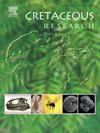Integrated stratigraphy and paleoceanography across the Santonian/Campanian boundary in the Budva Zone (Dinarides), Montenegro
IF 1.7
3区 地球科学
Q1 GEOLOGY
引用次数: 0
Abstract
This paper examines the 42 m thick Upper Cretaceous sedimentary succession of the Čanj section in the Budva Zone (Dinarides), Montenegro, with a focus on planktonic foraminifera and geochemical characteristics across the Santonian/Campanian boundary. The section features well-preserved red pelagic Scaglia-type limestones with occasional chert intercalations, similar to the Cretaceous Oceanic Red Beds (CORBs) observed worldwide. An integrated stratigraphic analysis, including biostratigraphy and chemostratigraphy, was conducted to identify isotopic signals and planktonic foraminiferal species that characterize this Tethyan facies, and to locate the Santonian/Campanian boundary. The lithostratigraphic framework of the section includes distinct members (RM1, RM2, and RM3), along with a notable White Member (WM) containing black chert layers. Stable isotopes (δ13Ccarb and δ18Ocarb) and elemental composition analyses on bulk carbonate samples reveal significant shifts in isotope ratios and element concentrations corresponding to lithologic transitions within the section. The occurrence of the planktonic foraminifera Dicarinella asymetrica in the WM marks an important biostratigraphic interval in the Santonian. The multiproxy approach revealed increased paleobioproductivity and a transgressive sea level phase in the WM during the Santonian in the western Tethys. Geochemical data suggest that the long-term sea-level rise was interrupted by smaller, short-term sea-level falls during the deposition of the studied pelagites. A comparative analysis with other Mediterranean CORBs and the Bottaccione section (Italy) highlights the regional significance of the Čanj sequence.
黑山布德瓦带(Dinarides)跨圣东-坎帕尼亚界线的综合地层学和古海洋学
本文研究了黑山Budva带(Dinarides) Čanj剖面42 m厚的上白垩统沉积演替,重点研究了浮游有孔虫和跨Santonian/Campanian边界的地球化学特征。该剖面以保存完好的红色远洋scagria型灰岩为特征,偶有硅质岩夹层,与世界范围内观察到的白垩纪海洋红层(corb)相似。通过生物地层学和化学地层学的综合地层学分析,确定了特提斯相的同位素信号和浮游有孔虫种类,并确定了三东-坎帕尼亚界线。该剖面的岩石地层格架包括不同的RM1、RM2和RM3段,以及一个著名的白色段(WM),其中含有黑色燧石层。整体碳酸盐样品的稳定同位素(δ 13ocarb和δ18Ocarb)和元素组成分析显示,剖面内的同位素比率和元素浓度与岩性转变相对应。WM浮游有孔虫Dicarinella asymmetrica的出现标志着三东系一个重要的生物地层层位。多代理方法揭示了古生物生产力的增加和西特提斯三东期的海侵海平面阶段。地球化学数据表明,在研究的层积岩沉积期间,长期的海平面上升被较小的短期海平面下降所中断。与其他地中海corb和意大利Bottaccione剖面的比较分析突出了Čanj序列的区域意义。
本文章由计算机程序翻译,如有差异,请以英文原文为准。
求助全文
约1分钟内获得全文
求助全文
来源期刊

Cretaceous Research
地学-地质学
CiteScore
4.10
自引率
19.00%
发文量
235
审稿时长
12 weeks
期刊介绍:
Cretaceous Research provides a forum for the rapid publication of research on all aspects of the Cretaceous Period, including its boundaries with the Jurassic and Palaeogene. Authoritative papers reporting detailed investigations of Cretaceous stratigraphy and palaeontology, studies of regional geology, and reviews of recently published books are complemented by short communications of significant new findings.
Papers submitted to Cretaceous Research should place the research in a broad context, with emphasis placed towards our better understanding of the Cretaceous, that are therefore of interest to the diverse, international readership of the journal. Full length papers that focus solely on a local theme or area will not be accepted for publication; authors of short communications are encouraged to discuss how their findings are of relevance to the Cretaceous on a broad scale.
Research Areas include:
• Regional geology
• Stratigraphy and palaeontology
• Palaeobiology
• Palaeobiogeography
• Palaeoceanography
• Palaeoclimatology
• Evolutionary Palaeoecology
• Geochronology
• Global events.
 求助内容:
求助内容: 应助结果提醒方式:
应助结果提醒方式:


